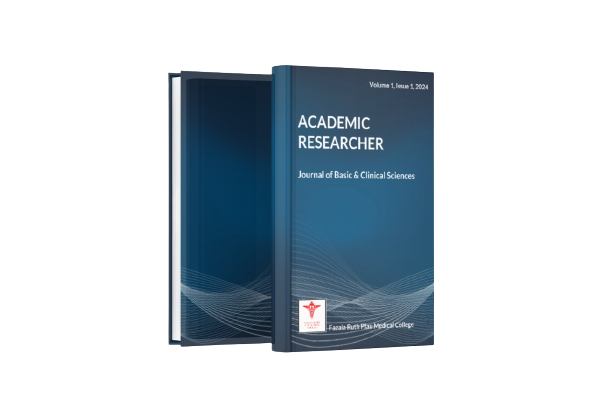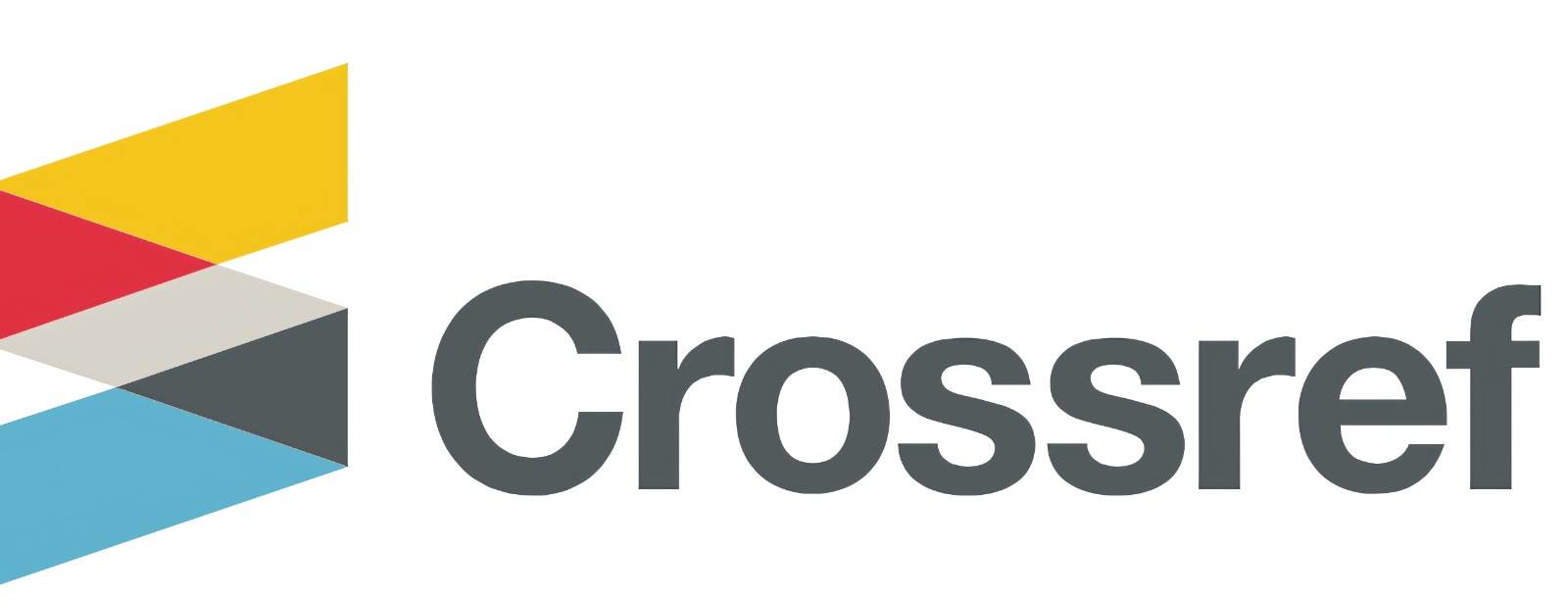

Academic Researcher
Journal of Basic and Clinical Sciences
Volume 02, Issue 01, 2025
An Official Journal of Fazaia Ruth Pfau Medical College, Air University
ISSN: 3008-0495 (Online)
ISSN: 3008-0487 (Print)
Instructions for Authors
MANUSCRIPT SUBMISSION
File Format
- Manuscript files must be in DOC, DOCX, or RTF format.
- Microsoft Word documents should not be locked or protected.
Length
Manuscripts can be of any length, without restrictions on word count, figures, or supporting information. However, Authors are encouraged to present and discuss their findings concisely.
Font
- Use any standard font size and standard font, except for the font named "Symbol."
- To add symbols to the manuscript, use the Insert → Symbol function in your word processor or paste in the appropriate Unicode character.
Headings
- Limit manuscript sections and sub-sections to 3 heading levels.
- Ensure heading levels are clearly indicated in the manuscript text and must be numbered.
Layout and Spacing
- Manuscript text should be double-spaced.
- Do not format text in multiple columns.
Page and Line Numbers
Include continuous page numbers and line numbers in the manuscript file.
Footnotes
Footnotes are not allowed in the manuscript. Move any footnote information into the main text or the reference list, as appropriate.
Language
- Manuscripts must be submitted in English.
- Translations of the manuscript or abstract may be submitted as supporting information, following the supporting information guidelines.
Abbreviations
- Define abbreviations upon first appearance in the text.
- Avoid non-standard abbreviations unless they appear at least three times in the text.
- Keep abbreviations to a minimum.
Reference Style
- Follow the "Vancouver" style, as outlined in the ICMJE sample references.
- Refer to reference formatting examples and additional instructions.
Equations
- Use MathType for display and inline equations whenever possible.
- If MathType is not available, Equation Editor or Microsoft's Insert → Equation function is acceptable.
- Avoid using equation tools for single variables, symbols, or mathematical operators in running text. Use Unicode values for single symbols.
- Include the entire equation, avoiding hybrid inline or display equations.
Nomenclature
- Use correct and established nomenclature whenever possible.
- Units of Measurement:
- Use SI units exclusively. If other units are used, provide the SI value in parentheses.
Drugs
Provide the Recommended International Non-Proprietary Name (rINN) for drugs.
Species Names
- Write species names in italics (e.g., Escherichia coli).
- Write out the full genus and species name in the title and at the first mention of an organism in the paper. After the first mention, use the first letter of the genus name followed by the full species name (e.g., E. coli).
Genes, Mutations, Genotypes, and Alleles
- Write gene names in italics. Use recommended names from appropriate genetic nomenclature databases (e.g., HGNC for human genes).
- Indicate synonyms for the gene the first time it appears in the text.
- Gene prefixes (e.g., v-fes, c-MYC) should be in roman typeface.
Allergens
- Use the systematic allergen nomenclature of the WHO/IUIS Allergen Nomenclature Sub- committee for manuscripts involving allergenic proteins.
- For manuscripts describing new allergens, obtain approval from the WHO/IUIS Allergen Nomenclature Sub-Committee before publication.
SECTIONS IN MANUSCRIPTS
Manuscripts submitted for research and review articles in the journal should be divided into the following sections.
Title Page
- The title of the article should be Specific, descriptive, concise, and comprehensible to readers outside the field and must not be more than 150 characters.
- Authors should avoid the use of non-standard abbreviations and question marks in titles.
- Titles should be written in sentence case (only the first word of the text, proper nouns, and genus names are capitalized)
- According to the reporting guidelines, information about the study should be a part of the title (particularly for systematic reviews and meta-analyses).
- Authors should also provide a short 'running title with no more than 100 characters' stating the topic of the study.
- Title page will have full names (First name, Middle name and Last name/surname) of all authors with affiliation (department, university, or organizational affiliation and its location, including city, state/province (if applicable), and country) and ORCID iD.
- In the end details of corresponding author(s), i.e., full names, complete affiliation/postal address, along with phone, fax and email.
- If an author has multiple affiliations, enter all affiliations on the title page only. In the submission system, enter only the preferred or primary affiliation. Author affiliations will be listed in the typeset PDF article in the same order that authors are listed in the submission.
Structured Abstract
- Describe the main objective(s) of the study
- Explain how the study was done, including any model organisms used, without methodological detail
- Summarize the most important results and their significance
- Must not exceed 300 words
- Abstracts should not include: Citations and Abbreviations (if possible)
After title page comes the abstract structured according to the followings:
All the original research articles must be accompanied following sub-headings; Background, Objective, Methods, Results, Conclusion. The headings may vary but must state the purpose of the study, details of the participants, measurements, methods, main findings and conclusion.
The clinical trial studies should have the registration number at the end of the study.
Keywords
Provide 6 to 8 keywords from the manuscript which may be part of title, repeated several times in the text and likely to appear in search of the relevant field.
Introduction
The introduction should start from new page. It should be comprehensive preferably providing background that puts the manuscript into context and allows readers outside the field to understand the purpose and significance of the study. Defining the problem addressed and why it is important. Including a brief review of the key literature. Concluding with a brief statement of the overall aim of the work and a comment about whether that aim was achieved.
Materials and Methods
Be concise: Write the Methods section as briefly as possible while still including all the essential
elements needed to interpret and reproduce your results. As a general guideline, it should not exceed
3,000 words.
New methods: If you are using new methods, provide a detailed description of these methods in your paper. This will help others to understand and replicate your work accurately.
Referencing established methods: For well-established methods, you can cite previous articles that describe these methods in detail. However, don't rely solely on these references; include enough information in your submission to make it understandable without needing to refer to those sources.
Protocol sharing: To increase reproducibility, consider depositing a comprehensive description of the protocols used in your study on a protocol sharing platform of your choice. This will allow others to access and follow your protocols more easily.
Avoiding excessive details: Avoid repeating detailed methods that have already been published
elsewhere. Instead, provide a reference number for those methods and state any new additions or
variations you made.
Subdivisions and subsections: Organize your Methods section with short and bold headings, referring tothe specific methods used. Consider creating subsections for statistics, reagents, and animal models to make it easier for readers to find relevant information.
Results
The important and main findings of the study should come first in the Results Section. The tables, figures and references should be given in sequence to emphasize the important information or observations related to the research. The repetition of data in tables and figures should be avoided. Results should be precise.
Discussion
This should explore the significance of the results of the work, present a reproducible procedure and emphasis the importance of the article in the light of recent developments in the field. Extensive citations and discussion of published literature should be avoided.
This section of research articles should discuss the implications of the findings in the context of existing research and highlight the study's limitations. The authors should justify the sample size according to the study purpose and methods.
The Results and Discussion may be presented together under one heading of “Results and Discussion”. Alternatively, they may be presented under two separate sections (“Results” section and “Discussion” Sections). Short sub-headings may be added in each section if required.
Conclusion
A small paragraph summarizing the contents of the article, presenting the final outcome of the research or proposing further study on the subject, may be given at the end of the article under the Conclusion section.
Consent for Publication
If the manuscript has an individual’s data, such as personal detail, audio-video material, etc., consent should be obtained from that individual. In the case of children, consent should be obtained from the parent or the legal guardian.
A specific declaration of such approval and consent-to-disclose form must be made in a stand-alone paragraph at the end of the article, especially in the case of human studies where the inclusion of a statement regarding obtaining the written informed consent from each subject or subject's guardian is a must. The original should be retained by the guarantor or corresponding author. Editors may request to provide the original forms by email.
If your manuscript does not contain data from any individual person, please state “Not applicable” in this section.
Availability of Data and Materials
- The datasets generated and/or analyzed during the study are available in the [NAME] repository, [PERSISTENT WEB LINK TO DATASETS].
- The datasets used and/or analyzed during the study are available from the corresponding author upon reasonable request.
- All data generated or analyzed during the study are included in the published article and its supplementary information files.
- The datasets generated and/or analyzed during the study are not publicly available due to specific reasons (mention the reason), but they are available from the corresponding author upon reasonable request.
- Data sharing is not applicable to this article as no datasets were generated or analyzed during the study.
- The data that support the findings are available from [third party name], but restrictions apply. Data are available from the authors upon reasonable request with permission from [third party name].
- If your manuscript does not contain any data, state "Not applicable."
Authors are required to include a statement In the manuscript explaining where the data supporting the
results can be found. It could be shared by providing hyperlinks to publicly archived datasets used or
created during your study. The data mentioned here should be the minimum dataset required for others
to understand, replicate, and build upon your findings.
Data availability options: Your data availability statement can take one of the following forms, or a
combination if you have multiple datasets:
Conflict of Interest
All individuals involved in the peer review process, including authors, editors and reviewers are required to declare any potential competing interests. Competing interests can be financial or non-financial, professional, or personal. Competing interests can arise in relationship to an institution, organization, or another person. Where authors have no competing interests, the statement should read “The author(s) declare(s) that they have no competing interests”.
Acknowledgements
Please acknowledge anyone who contributed towards the article who does not meet the criteria for
authorship including anyone who provided professional writing services or materials.
See our Editorial Policies for a full explanation of acknowledgements and authorship criteria.
Citations
- Any statement in the manuscript that relies on external sources of information (i.e. not the authors' own new ideas or findings or general knowledge) should use a citation.
- Authors should avoid citing derivations of original work. For example, they should cite the original work rather than a review article that cites an original work.
- Authors should ensure that their citations are accurate (i.e. they should ensure the citation supports the statement made in their manuscript and should not misrepresent another work by citing it if it does not support the point the authors wish to make).
- Authors should not cite sources that they have not read.
- Authors should not preferentially cite their own or their friends’, peers’, or institution’s publications.
- Authors should avoid citing work solely from one country.
- Authors should not use an excessive number of citations to support one point.
- Ideally, authors should cite sources that have undergone peer review where possible.
- Authors should not cite advertisements or advertorial material.
- The preprints may be cited in the reference section as follows; Author(s). Title of the manuscript. Preprint at [URL] (Year).
Authors should consider the following guidelines when preparing their manuscript:
References
References should be submitted preferably in the Vancouver style. Also, view the section “References” in the editorial policies.
All references must be complete and accurate. The reference numbers must be finalized and the bibliography must be fully formatted before submission.
The references should be relevant to the study and should refer to the original research sources. Self- citation and self-interest should be avoided by the authors, editors and peer-reviewers.
Some examples of the preferable reference style are listed below:
Journal References
Hotz P, Carbonnelle P, Scheiff JM, Tschopp A, Lauwerys R. Interleukin 1 alpha hematological examination in mechanics exposed to low benzene concentrations. Int Arch Occup Environ Health. 1998; 71(1): 19- 28. doi 10.1007/s004200050245.
Tse TJ, Purdy SK, Shen J, Nelson FB, Mustafa R, Wiens DJ, et al. Toxicology of alcohol-based hand rubs formulated with technical-grade ethanol. Toxicol Rep. 2021; 8: 785-792. doi: 10.1016/j.toxrep.2021.03.034
Frumin AM, Nussbaum J, Esposito M. Functional asplenia: demonstration of splenic activity by bone marrow scan. Blood 1979; 59 (Suppl 1): 26-32.
Accepted, unpublished articles
Frumin AM, Nussbaum J, Esposito M. Functional asplenia: demonstration of splenic activity by bone marrow scan. Blood 2023; epub ahead.
Preprint
Krick T, Shub DA, Verstraete N, Ferreiro DU, Alonso LG, Shub M, et al. Amino acid metabolism conflicts with protein diversity. arXiv: 1403.3301v1 [Preprint]. 2014. Available from: https://128.84.21.199/abs/1403.3301v1
Book
Plewig G, French L, Ruzicka T, Kaufmann R, Hertl M. Braun-Falco´s Dermatology. 4 th ed. Germany: Springer; 2000. pp. 1053–82.
Chapter In Book
Wyllie AH, Kerr JFR, Currie AR. Cell death: the significance of apoptosis. In: Bourne GH, Danielli JF, Jeon KW, Eds. International review of cytology. London: Academic; 1980. p. 251-306.
Masters' Theses Or Doctoral Dissertations
Wells A. Exploring the development of the independent, electronic, scholarly journal. M.Sc. Thesis, The University of Sheffield. 1999. Available from: http://cumincad.scix.net/cgi-bin/works/Show?2e09
Patent
Lebold TP, Dvorak CA, Coate HR, Ziff JM, Preville C, Shireman BT. Substituted 2-azabicycles and their use as orexin receptor modulators. WO2016040789A1 (2016).
Conference Proceedings
Kimura J, Shibasaki H, Eds. Recent advances in clinical neurophysiology. Proceedings of the 10th International Congress of EMG and Clinical Neurophysiology; 1995 Oct 15-19; Kyoto, Japan. Amsterdam: Elsevier 1996.
Howe B, Lee P, Grechkin M, Yang ST, West JD. Deep mapping of the visual literature. In: Proceedings of the 26th International Conference on World Wide Web Companion [Internet]; 2017 Apr 3-7; Perth, Australia. Geneva; International World Wide Web Conferences Steering Committee; 2017, p. 1273–7. Available from: ACM Digital Library doi:10.1145/3041021.3053065
Bowden FJ, Fairley CK. Endemic STDs in the Northern Territory: estimations of effective rates of partner exchange. Paper presented at: The Scientific Meeting of the Royal Australian College of Physicians; 1996 Jun 24-25; Darwin.
Harris AH, editor. Economics and health. Proceedings of the 19th Australian Conference of Health Economists; 1997 Sep 13-14; Sydney, AU. Kensington (AU): School of Health Services Management, University of New South Wales; 1998.
Appendices
- This section If you have lengthy but essential methodological details to present, use appendices.
- Appendices are part of the article but must be kept concise, not exceeding three pages.
- Use Times New Roman font, 10-point size, with a maximum of 900 words per page.
- Title a single appendix as "APPENDIX," and if there are multiple appendices, label them as "APPENDIX A," "APPENDIX B," and so on.
Supportive/Supplementary Material
List supporting information captions at the end of the manuscript file. Do not submit captions in a separate file. Authors may use almost any description as the item name for a supporting information file as long as it contains an “S” and number. For example, “S1 Appendix” and “S2 Appendix,” “S1 Table” and “S2 Table,” and so forth. Authors can submit essential supporting files and multimedia files along with their manuscripts. All supporting information will be subject to peer review. Submit all supportive material in a single zipped file, not exceeding 4 MB in size. Additional files will be linked to the final published article but not displayed within the paper itself.
Figures
- EPS (preferred format for diagrams)
- PDF (especially suitable for diagrams)
- PNG (preferred format for photos or images)
- Microsoft Word (version 5 and above; figures must be a single page)
- PowerPoint (figures must be a single page)
- TIFF
- JPEG (convert from the original file)
- BMP
- CDX (ChemDraw)
- TGF (ISISDraw)
- Graphics embedded in word processor documents (e.g., Word, Excel, PowerPoint).
- Optimized files for screen use (e.g., GIF, BMP, PICT, WPG) due to their low resolution.
- Files with excessively low resolution that may compromise visibility.
- Graphics that are disproportionately large for the content, which can lead to formatting issues.
The figures submitted with the manuscript must be of good quality in any version of PDF, PPT, MS Word, TIFF or JPEG. Manuscripts with Blur and distorted images will not be acceptable. Embed the illustrations directly within the text file of your manuscript. Figure captions must be inserted in the text of the manuscript, immediately following the paragraph in which the figure is first cited (read order). Do not include captions as part of the figure files themselves or submit them in a separate document. A figure label with Arabic numerals, and “Figure” abbreviated to “Fig” (e.g. Fig 1, Fig 2, Fig 3, etc). Match the label of your figure with the name of the file uploaded at submission (e.g. a figure citation of “Fig 1” must refer to a figure file named “Fig1.tif”).
If a figure consists of multiple parts, combine them into a single composite illustration file. Ensure all numbers, symbols, and letters in your figures are consistent and clear throughout, and they should be large enough to remain readable even when the size is reduced for publication.
Scaling/Resolution
Please choose the appropriate image type for your illustrations:
For Line Art: Use TIFF or EPS format with a color mode of Monochrome 1-bit or RGB, and a resolution of 900-1200 dpi. For Halftone: Utilize TIFF format with a color mode of RGB or Grayscale, and a resolution of 300 dpi. For Combination: Opt for TIFF format with a color mode of RGB or Grayscale, and a resolution of 500- 900 dpi.
Accepted File Formats
You can use various file formats for your illustrations, such as:
To maintain the quality and clarity of your figures, please avoid using the following formats and practices:
Tables
- Data Tables should be submitted in Microsoft Word table format not as graphical object. Use the table tool in your text editing software to create tables. If necessary, create tables in Excel and insert them into the manuscript. Do not insert text boxes or graphics within your tables.
- Place the caption with the table in the manuscript. Captions include 3 main elements.
1) Label: in the format of “Table 1”. Number your tables with Arabic numerals.
2) Title: brief, descriptive, and placed above the table in small case with the first letter in caps.
3) Legend, Footnotes: placed below the table. - Tables should be embedded in the text exactly according to their appropriate placement in the submitted manuscript.
- Columns and rows of data should be made visibly distinct by ensuring that the borders of each cell are displayed.
- Tables should be numbered in Arabic numerals sequentially in order of their citation in the body of the text.
- Symbols and nonstandard abbreviations should be explained in the footnote.
- All references should be numbered sequentially [in square brackets] in the table and listed in the same numerical order in the reference section.








